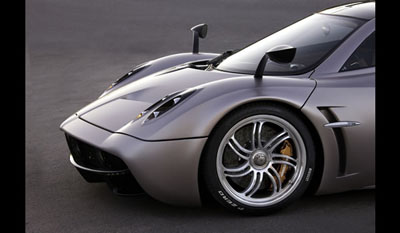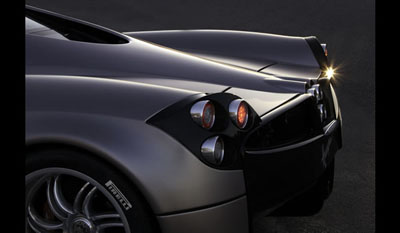Pagani Huayra 2011
« Elegant and muscular the Huayra merges the past, present and future in a timeless interpretation of
automotive art. » Pagani defines the new Huayra 2011.
The styling of the Pagani Huayra was perfected over the course of 5 years to find each line’s beginning and end. During this study, eight scale models were created, as well as two 1:1 models, each an evolution of the previous in a never ending quest to perfect the form and refining the
substance.
The bi-xenon headlamps are just one of the many precious gifts from the Zonda R, and LED
daytime running lights are seamlessly integrated in the elliptical shape of the design. The rear
bumper integrates with the diffuser and is dominated by an elliptical frame that surrounds the
four central exhaust outlets, now becoming a characteristic Pagani element.
The new central monocoque on the Pagani Huayra is an entirely new design made from carbontitanium.
However, with the gull wing doors cutting deep into the roof, much research was
focused on achieving the highest levels of rigidity through the application of new advanced
composite materials and technologies first tested on the Zonda R. The fuel tank is located
integrally in the best protected area of the monocoque, behind the driver, reinforced by safety
cell made of different composite and ballistic materials. The front and rear CrMo subframes
offer an exceptional rigidity-to-weight ratio to allowing the suspensions to work at their best
while incorporating an advanced energy absorbing crash structure.
Mercedes-AMG provides the heart for the Pagani Huayra. The 60 degree 12 cylinder turbocharged
engine with a displacement of 5980 cm3 has been developed not just to meet the strictest
technical and quality requirements, but also to give the car its many faces.
The engine’s systems have been designed and tested to stand up to the most adverse conditions
of temperature and performance. The Huayra has been subjected to the highs of Death Valley
and the lows of the Arctic Circle. The two lateral radiators are positioned in the front to
guarantee the best cooling efficiency of the intercoolers placed over the cylinder heads. Dry
sump lubrication ensures an optimal oil feed to the engine even when the car is subjected to
the most extreme lateral accelerations. It also regulates the oil flow so that only the necessary
amount of lubricant is actually pumped into the engine from the external oil tank, reducing
the friction caused by an excessive volume of lubricant inside the engine sump. An oil/water
heat exchanger reduces warm-up times by heating the engine lubricant during cold start and
keeps engine coolant and lubricant levels at steady operational temperatures.
The M158 engine is homologated to meet the strictest environmental regulations, EU5 and
LEV2. Despite the increase of power compared to the other Mercedes-AMG V12 engines
developed for Pagani, CO2 emissions as well as the fuel consumption have been reduced, to
make the Huayra class leading amongst 12 cylinder sports cars with values that are respective
of much smaller vehicles in the market. The two stage fuel supply system features two
microprocessor controlled pumps feeding fuel to the engine with the second pump only
activated when necessary, thus reducing the energy required to run the fuel pumps and
eliminates the waste of excessive fuel being transported and heated in the fuel lines. This
efficiency combined with a large 85 liter fuel tank ensure Huayra’s grand touring ability.
 |
 |
| |
|
The power and prodigious torque generated by Huayra’s V12 are transferred to the wheels
through a transverse sequential seven speed gearbox and a dual plate clutch and the complete
gearbox weighs only 96 kg. Keeping the weight of the rear overhang as low as possible has
been a priority as we aim for a neutral behavior at the limit. A further benefit of this layout is
a better behavior of the car during a rear impact. A dual clutch system was evaluated but
ultimately not selected as it would have increased the weight by approximately 70kg, thus
negating any minor improvement in shift-time.
Xtrac already supplied the gearbox for the Zonda R and so it was the natural choice for the
development of a new high performance gearbox. Xtrac’s expertise in motorsports was obvious
throughout the design and material selection processes that resulted in the strongest and
lightest gearbox possible suitable for road use, with a synchromesh box that offers comfort
levels a race car gearbox will never be able to offer.
The suspension geometry has been designed to further enhance the sure-footed nature already
present in the Zonda on the longer wheelbase Huayra. The individual suspension made with
forged AvionAl double A-arms have been tested extensively on the Zonda R programme.
Incorporated into the wheel hub assemblies are cooling ducts that connect directly to the
support brackets, thus extending the reliability and lifespan of the bearings. Pushrod operated
adjustable Öhlins shock absorbers keep everything under control and have been optimized for
the dynamic requirements of the Pagani Huayra.
The aerodynamic concept of the Huayra is that of a wing. The vehicle can modify the properties
of this wing by varying the front ride height, which can be adjusted dynamically, and by adjusting
the 4 control flaps on each of the four corners of the car.
The system improves aerodynamic efficiency in a variety of driving conditions, where a low
drag coefficient is not the determining factor. During braking, for example, the rear flaps and
the front suspension are raised to counteract the weight transfer and balance the weight
distribution between front and rear axles, allowing a better use of the rear brake force.
Another vital design tenant for the Huayra project was to ensure clean airflow over the body
of the car.
The shape of the two engine air intakes behind the occupants shoulders are a tribute
to the supersonic aircraft of the late 1950s and 1960s, but also allow the motor breath without
disrupting the flow. The intake for the gearbox radiator is located between the engine bay
window and the carbon clamshell of the rear bonnet, which provides an excellent airflow to
the radiator without having a substantial impact on aerodynamic drag. This decision also led
to the omission of a rear wing, replaced by the movable flaps.
The flow of air through the car was also carefully studied. The radiators are angled to contribute
downforce and provide the best flow for hot air to be extracted. Air from the central radiator
is extracted by vents on the front bonnet and trough the front wheelhouses. Air from the side
radiators is channeled to ducts cooling the brake discs and wheel hubs. This air blows onto
the brakes at a temperature of approximately 50°C warming the brakes up when cold and
improving the first bite significantly. Lateral air outlets behind the front wheels generate a
negative pressure inside the wheelhouse providing efficient extraction to lower the drag
coefficient and generate downforce on the front.
In addition to the downforce generated by the flaps and body, two high negative pressure
areas were designed into the shape of the underbody and the diffuser at the rear, thus enhancing
the aerodynamic stability and guaranteeing the Huayra downforce under all circumstances.
Pagani Huayra Technical data:
Engine: |
Mercedes-AMG M158 V12 twin-Turbo - 5980 cc - 700 HP |
| Torque |
1.000 Nm |
Gearbox: |
transverse sequential seven speed gearbox -
AMT robotyzed system with driving programs |
Dimensions: |
length: 4605mm -
height: 1169mm - width: 2036mm |
| Dry weight: |
1.350 kg |
| Weight distribution: |
44% front 56% rear |
Wallpapers : Pagani Huayra 2011